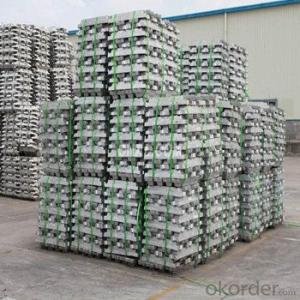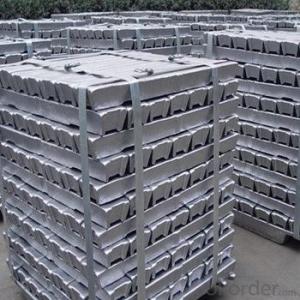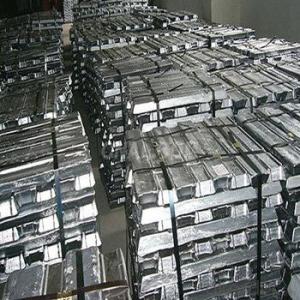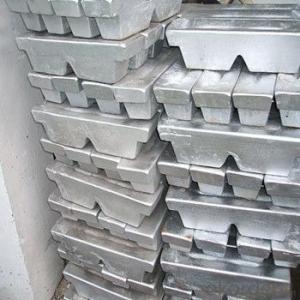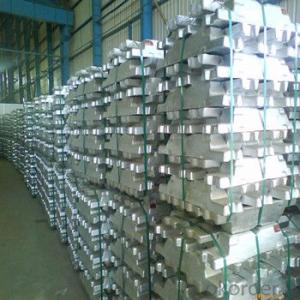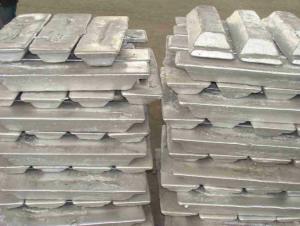Aluminum Ingot 99.7% Hot Selling With Best Price
- Loading Port:
- China main port
- Payment Terms:
- TT OR LC
- Min Order Qty:
- 1000 m.t
- Supply Capability:
- 10000 m.t/month
OKorder Service Pledge
OKorder Financial Service
You Might Also Like
Pure Aluminum Ingot Used for Industry
1.Structure of Aluminum Ingot Description
An ingot is a piece of material, usually metal, that is cast into a shape suitable for further processing. Insteelmaking, it is the first step among semi-finished casting products. Ingots usually require a second procedure of shaping, such as cold/hot working, cutting, or milling to produce a useful final product. Non-metallic and semiconductor materials prepared in bulk form may also be referred to as ingots, particularly when cast by mold based methods.
2.Main Features of the Aluminum Ingot
•High Purity
•High strength
•Fast melting
•Best price
•Good after-service
3. Aluminum Ingot Images
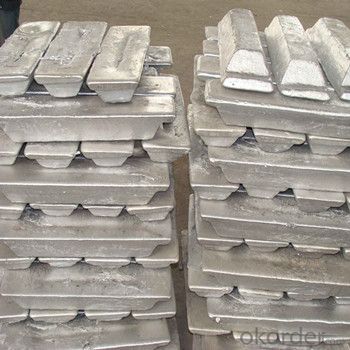
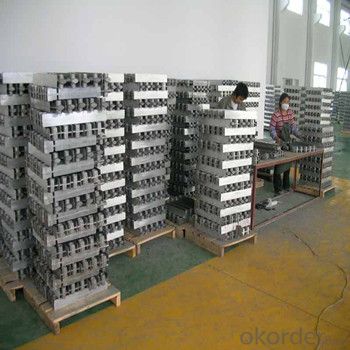
4. Aluminum Ingot Specification
Grade | Chemical Composition % | |||||||||
Al≥ | impurities ≤ | |||||||||
Si | Fe | Cu | Ga | Mg | Zn | Mn | others | Sum | ||
Al99.9 | 99.90 | 0.50 | 0.07 | 0.005 | 0.02 | 0.01 | 0.025 | - | 0.010 | 0.10 |
Al99.85 | 99.85 | 0.80 | 0.12 | 0.005 | 0.03 | 0.02 | 0.030 | - | 0.015 | 0.15 |
Al99.7 | 99.70 | 0.10 | 0.20 | 0.010 | 0.03 | 0.02 | 0.030 | - | 0.030 | 0.30 |
Al99.6 | 99.60 | 0.16 | 0.25 | 0.010 | 0.03 | 0.03 | 0.030 | - | 0.030 | 0.40 |
Al99.5 | 99.50 | 0.22 | 0.30 | 0.020 | 0.03 | 0.05 | 0.050 | - | 0.030 | 0.50 |
Al99.00 | 99.00 | 0.42 | 0.50 | 0.020 | 0.03 | 0.05 | 0.050 | - | 0.050 | 1.00 |
5.FAQ of Aluminum Ingot
We have organized several common questions for our clients,may help you sincerely:
①How about your company?
A world class manufacturer & supplier of castings forging in carbon steel and alloy steel,is one of the large-scale professional investment casting production bases in China,consisting of both casting foundry forging and machining factory. Annually more than 8000 tons Precision casting and forging parts are exported to markets in Europe,America and Japan. OEM casting and forging service available according to customer’s requirements.
②How to guarantee the quality of the products?
We have established the international advanced quality management system,every link from raw material to final product we have strict quality test;We resolutely put an end to unqualified products flowing into the market. At the same time, we will provide necessary follow-up service assurance.
③How long can we receive the product after purchase?
In the purchase of product within three working days, We will arrange the factory delivery as soon as possible. The pecific time of receiving is related to the state and position of customers.Commonly 7 to 10 working days can be served.
- Q:What is the role of aluminum ingots in the production of aircraft?
- Aircraft production heavily relies on aluminum ingots because of their unique properties and characteristics. In essence, aluminum ingots, which are blocks or bars of pure aluminum, serve as the primary raw material for making various components and structures in aircraft. The outstanding strength-to-weight ratio of aluminum ingots is one of the main reasons why they are preferred in aircraft production. Aluminum is a lightweight metal, making it perfect for aerospace applications where reducing weight is crucial for fuel efficiency and overall performance. By using aluminum ingots, manufacturers can create lightweight parts that contribute to reducing the overall weight of an aircraft. This leads to improved fuel economy and increased payload capacity. In addition, aluminum ingots possess remarkable corrosion resistance, even in harsh environments. This property is particularly important for aircraft as they are exposed to different atmospheric conditions, including moisture, salt, and pollutants. Aluminum's corrosion resistance helps ensure the durability and longevity of aircraft components, leading to reduced maintenance costs and enhanced safety. Furthermore, aluminum ingots are highly malleable and easily shaped, allowing manufacturers to form them into desired aircraft components through various manufacturing processes such as forging, extrusion, and machining. This versatility enables the production of complex parts, such as fuselage panels, wings, and landing gear, with precision and efficiency. Aside from their mechanical properties, aluminum ingots also exhibit excellent thermal conductivity. This characteristic is valuable in aircraft applications as it helps dissipate heat generated by engines, electronic systems, and other components. By efficiently transferring heat away from critical areas, aluminum contributes to the overall thermal management of an aircraft, enhancing performance and preventing overheating. In conclusion, aluminum ingots are essential in aircraft production due to their lightweight nature, corrosion resistance, malleability, and thermal conductivity. These properties enable the manufacturing of strong, durable, and efficient aircraft structures and components, which ultimately contribute to the safety, performance, and reliability of modern aircraft.
- Q:Casting aluminum ingot, environmental protection has those requirements?.
- Our company can according to the user's site conditions and the need to select the appropriate cooler for the user, there are several types of dust removal system commonly used: natural air cooling + bag, air cooler + bag.
- Q:Why is there a lot of glue after the aluminium ingot is melted?
- Maybe the temperature is not high enough;
- Q:What are the different forging techniques for aluminum ingots?
- There are several different forging techniques used for aluminum ingots, each offering unique advantages and applications. Some of the most common techniques include: 1. Open-die forging: Also known as smith forging or hand forging, this technique involves shaping the aluminum ingot between flat dies. The ingot is heated and then hammered or pressed into the desired shape. Open-die forging is ideal for producing simple shapes and is often used for creating customized or one-of-a-kind components. 2. Closed-die forging: In this method, also referred to as impression forging or impression die forging, the aluminum ingot is placed within a set of dies with a pre-designed cavity. The ingot is then subjected to high pressure, causing it to fill the cavity and take the shape of the dies. Closed-die forging allows for more complex shapes and tighter tolerances, making it suitable for mass production of components. 3. Upset forging: This technique involves increasing the diameter or thickness of the aluminum ingot by compressing it between flat or shaped dies. The ingot is placed horizontally between the dies, and pressure is applied vertically to create the desired shape. Upset forging is particularly useful for creating parts with increased cross-sectional area, such as shafts, bolts, or axles. 4. Press forging: Press forging, also known as mechanical forging, involves using a mechanical press to apply pressure to the aluminum ingot. The ingot is placed between the dies, and pressure is applied in a slow and controlled manner, allowing for precise shaping. Press forging is commonly used for producing components with complex shapes, high dimensional accuracy, and fine surface finishes. 5. Roll forging: In this technique, the aluminum ingot is subjected to pressure by passing it between a pair of rotating rolls. The rolls have specially designed contours that shape the ingot as it passes through them. Roll forging is often used to produce long, cylindrical components like bars, shafts, or tubes. It offers excellent dimensional control and surface finish. These forging techniques can be combined or modified to suit specific requirements, and the selection of the most appropriate technique depends on factors such as the complexity of the desired shape, production volume, cost considerations, and material properties.
- Q:What is the casting process for aluminum ingots?
- The casting process for aluminum ingots involves several steps to ensure the production of high-quality, uniform ingots. First, the raw aluminum is melted in a furnace at temperatures exceeding 660 degrees Celsius (1220 degrees Fahrenheit). The molten aluminum is then transferred to a holding furnace, where it is maintained at a consistent temperature to prevent solidification. Next, a mold is prepared for casting the aluminum ingots. The mold is typically made of steel or cast iron and is preheated to minimize thermal shock. The mold is also coated with a release agent to prevent the ingot from sticking to the mold. Once the mold is ready, the molten aluminum is poured into it. The pouring process can be done manually or using automated equipment, depending on the scale of production. The molten aluminum fills the mold, taking the shape of the desired ingot. After pouring, the mold is allowed to cool and solidify the aluminum. Cooling time varies depending on the size and thickness of the ingot. As the aluminum cools, it undergoes a phase transformation from liquid to solid, forming a solid ingot. Once the ingot is solidified, it is removed from the mold. This can be achieved by either manually removing the ingot or using mechanical means, such as vibrators or hydraulic presses, to eject the ingot from the mold. Finally, the ingots are typically subjected to further processing, such as heat treatment or surface finishing, to enhance their mechanical properties and appearance. These additional steps may include homogenizing the ingots to ensure uniformity, removing surface defects, or applying protective coatings. Overall, the casting process for aluminum ingots is a complex and precise operation that requires careful control of temperature, mold preparation, and post-processing steps to produce high-quality ingots suitable for further aluminum processing and applications.
- Q:Does the pure aluminium ingot need to be removed in addition to the slag after melting?
- The pure aluminum ingot also needs to be removed in addition to the slag after melting. Because there will be air absorption in the process of melting, the slag will also be generated.
- Q:What are the different joining techniques for aluminum ingots?
- Different joining techniques can be utilized for aluminum ingots depending on their specific requirements and applications. Some commonly used methods for joining aluminum ingots are as follows: 1. Welding: The most frequently employed technique for joining aluminum ingots is welding. Various welding methods, such as gas metal arc welding (GMAW), tungsten inert gas welding (TIG), and friction stir welding (FSW), can be utilized. Welding involves melting the aluminum material and joining it together either with or without a filler metal. 2. Brazing: This technique involves joining aluminum ingots using a filler material with a lower melting point than the base metal. The filler material is heated above its melting point and distributed between the aluminum ingots, resulting in a strong bond as it solidifies. Brazing is commonly used when joining aluminum parts with complex geometries or when a lower heat input is required. 3. Adhesive bonding: This method involves using specialized adhesives to join aluminum ingots. Adhesive bonding is an efficient and cost-effective technique that does not require high temperatures or specialized equipment. It can create durable and robust bonds, particularly when combined with surface preparation techniques such as cleaning and roughening. 4. Mechanical fastening: This technique involves joining aluminum ingots using mechanical fasteners like screws, bolts, rivets, or nuts and bolts. Mechanical fastening is a relatively simple and cost-effective method that does not require any specialized equipment or high temperatures. It provides a strong and reliable joint, particularly when combined with techniques like pre-drilling or using threaded inserts. 5. Friction stir processing: This technique is a variation of friction stir welding. It employs a rotating tool to generate heat and friction, transforming the aluminum ingots into a semi-solid state. This process can improve the grain structure and mechanical properties of the joint, making it suitable for applications requiring enhanced strength or fatigue resistance. When selecting the appropriate joining technique for aluminum ingots, it is crucial to consider specific requirements, constraints, and desired properties. Factors such as joint strength, cost, time, and the availability of equipment and expertise should all be taken into account to ensure the most suitable joining method is employed.
- Q:How do aluminum ingots contribute to the overall aluminum industry?
- Aluminum ingots play a crucial role in the overall aluminum industry as they serve as the primary raw material for the production of various aluminum products. Ingots are formed by smelting aluminum ore and then pouring the molten metal into molds to solidify. One significant contribution of aluminum ingots is their versatility. They can be further processed and shaped into different forms, such as sheets, plates, rods, tubes, and extrusions, which are used in a wide range of industries. These include automotive, aerospace, construction, packaging, electrical, and consumer goods sectors. Furthermore, aluminum ingots offer several advantages that contribute to the growth and sustainability of the aluminum industry. Aluminum is lightweight, corrosion-resistant, and possesses excellent conductivity, making it an ideal choice for many applications. Its low density allows for energy efficiency in transportation, reducing fuel consumption and emissions in the automotive and aviation sectors. Additionally, aluminum's corrosion resistance ensures longer-lasting products, reducing maintenance and replacement costs. The availability and affordability of aluminum ingots also contribute to the overall aluminum industry. Aluminum is the third most abundant element on Earth's crust and can be easily extracted from bauxite ore. This accessibility, combined with efficient production processes, makes aluminum ingots readily available for manufacturers at competitive prices, stimulating demand and market growth. Moreover, the recycling potential of aluminum ingots plays a significant role in the sustainability of the aluminum industry. Aluminum is infinitely recyclable, meaning it can be melted and reused without any loss in quality. Recycling aluminum requires only a fraction of the energy compared to primary production, resulting in significant energy savings and reduced environmental impact. The use of recycled aluminum ingots helps in conserving natural resources, reducing waste, and lowering carbon emissions. In conclusion, aluminum ingots are essential to the overall aluminum industry as they provide the raw material that is processed into a wide variety of aluminum products. Their versatility, lightweight nature, corrosion resistance, and recyclability make them highly valuable for multiple industries. The availability and affordability of aluminum ingots further contribute to the growth and sustainability of the aluminum industry, while their recycling potential helps in conserving resources and reducing environmental impact.
- Q:What is the role of aluminum ingots in the production of aircraft engines?
- Aluminum ingots are of utmost importance when it comes to manufacturing aircraft engines. This lightweight metal possesses exceptional strength, high thermal conductivity, and excellent corrosion resistance, which makes it an ideal material for various components in aircraft engines. One major application of aluminum ingots in aircraft engines is the production of engine casings. These casings serve as protective housing for internal engine components like the combustion chamber, turbine, and compressor. Thanks to aluminum's lightweight nature, the overall weight of the engine can be reduced, resulting in improved fuel efficiency and enhanced aircraft performance. Moreover, aluminum ingots are utilized in the manufacturing of engine components such as pistons, cylinder heads, and connecting rods. These parts require a combination of strength, durability, and heat dissipation properties, all of which can be provided by aluminum. By incorporating aluminum ingots into these components, engine manufacturers can achieve a balance between weight reduction and ensuring structural integrity. Furthermore, heat exchangers and cooling systems within aircraft engines are fabricated using aluminum ingots. These systems play a crucial role in regulating the temperature of various engine parts, ensuring optimal performance and preventing overheating. Aluminum's high thermal conductivity allows for efficient heat transfer, making it an excellent choice for these applications. In addition to its material properties, aluminum ingots are favored for their ease of processing and manufacturing. Aluminum can be cast, forged, extruded, and machined into intricate shapes and designs, enabling the production of engine components with precise specifications. Overall, aluminum ingots play an indispensable role in the production of aircraft engines. Their lightweight nature, strength, thermal conductivity, corrosion resistance, and ease of processing make them the preferred material for manufacturing engine casings, components, and cooling systems. By incorporating aluminum ingots into aircraft engine production, the overall performance, efficiency, and reliability of modern aircraft are significantly enhanced.
- Q:What method does common smelting aluminium ingot adopt now?
- Only the electric stove, the stove is not expensive, the electricity price is relatively stable, melts one ton aluminum ingot, theoretically consumes 500 degrees, moreover the power consumption itself does not have the pollution, should be the first choice.
1. Manufacturer Overview |
|
|---|---|
| Location | |
| Year Established | |
| Annual Output Value | |
| Main Markets | |
| Company Certifications | |
2. Manufacturer Certificates |
|
|---|---|
| a) Certification Name | |
| Range | |
| Reference | |
| Validity Period | |
3. Manufacturer Capability |
|
|---|---|
| a)Trade Capacity | |
| Nearest Port | |
| Export Percentage | |
| No.of Employees in Trade Department | |
| Language Spoken: | |
| b)Factory Information | |
| Factory Size: | |
| No. of Production Lines | |
| Contract Manufacturing | |
| Product Price Range | |
Send your message to us
Aluminum Ingot 99.7% Hot Selling With Best Price
- Loading Port:
- China main port
- Payment Terms:
- TT OR LC
- Min Order Qty:
- 1000 m.t
- Supply Capability:
- 10000 m.t/month
OKorder Service Pledge
OKorder Financial Service
Similar products
New products
Hot products
Related keywords
